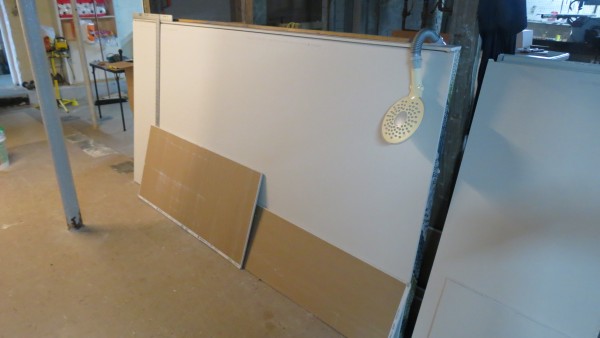
These pieces of sheetrock were used to replace mold-ravaged walls in a basement in Howard Beach that was destroyed by Superstorm Sandy.
Last week, we used this space to define mold and how it can possibly affect your health and the well-being of the more vulnerable among us.
Now that we understand it and how it can impact our daily lives, the next step is to learn how to remove mold and contain the contamination.
***
Mold will grow in your house after any storm or accident that involves flooding. And if not treated properly and removed, it can make you sick. According to the U.S. Centers for Disease Control and Prevention, certain steps should be carefully followed when removing mold from your home, including: Take things that were wet for two or more days outside—things that stayed wet for two days have mold growing on them, even if you can’t see it; take out stuff made of cloth, unless you can wash them in hot water; also take out stuff that can’t be cleaned easily (i.e. leather, paper, wood, and carpet); use bleach to clean mold off hard things (like floors, stoves, sinks, certain toys, countertops, flatware, plates, and tools.)
Additionally, while cleaning: never mix bleach with ammonia or other cleaners; wear rubber boots, rubber gloves, goggles, and an N-95 mask; open windows and doors to get fresh air when you use bleach; mix no more than one cup of bleach in one gallon of water; wash the item with the bleach and water mixture; if the surface of the item is rough, scrub the surface with a stiff brush; rinse the item with clean water; dry the item or leave it out to dry.
***
During a flood cleanup, according to the U.S. Department of Environmental Protection Office of Air and Radiation, the indoor air quality in your home or office may appear to be the least of your problems. However, failure to remove contaminated materials and to reduce moisture and humidity can present serious long-term health risks. Standing water and wet materials are a breeding ground for microorganisms, such as viruses, bacteria, and mold. They can cause disease, trigger allergic reactions, and continue to damage materials long after the flood.
Excess moisture in the home is an indoor air quality concern for three reasons, according to the DEP: Microorganisms brought into the home during flooding may present a health hazard. These organisms can penetrate deep into soaked, porous materials and later be released into air or water. Coming in contact with air or water that contains these organisms can make you sick. Also, high humidity and moist materials provide ideal environments for the excessive growth of microorganisms that are always present in the home. This may result in additional health concerns such as allergic reactions. And long-term increases in humidity in the home can also foster the growth of dust mites. Dust mites are a major cause of allergic reactions and asthma.
For more information, visit the EPA’s website on natural disasters: Flooding at epa.gov/naturaldisasters/flooding.html.
By Michael V. Cusenza
